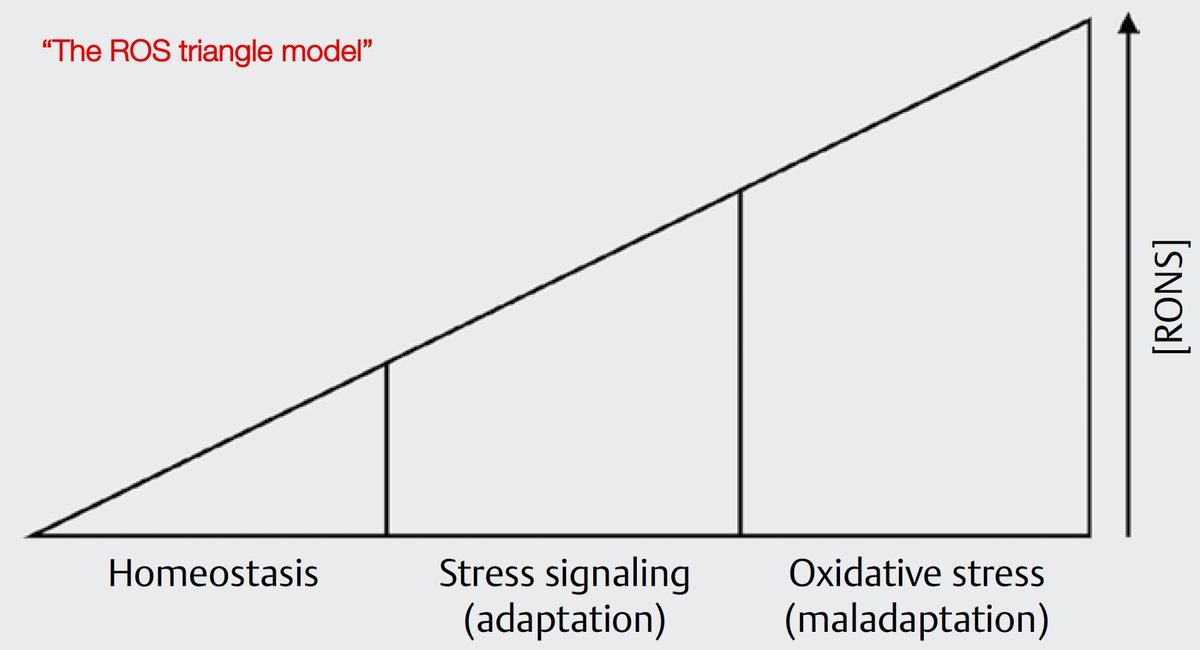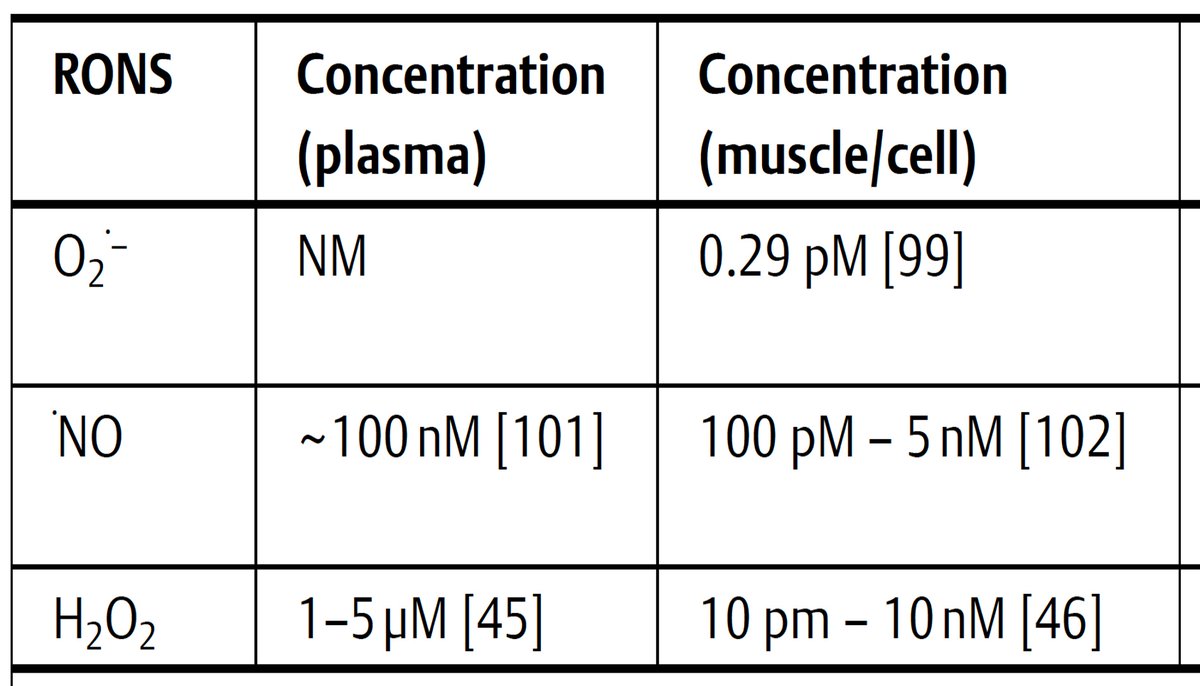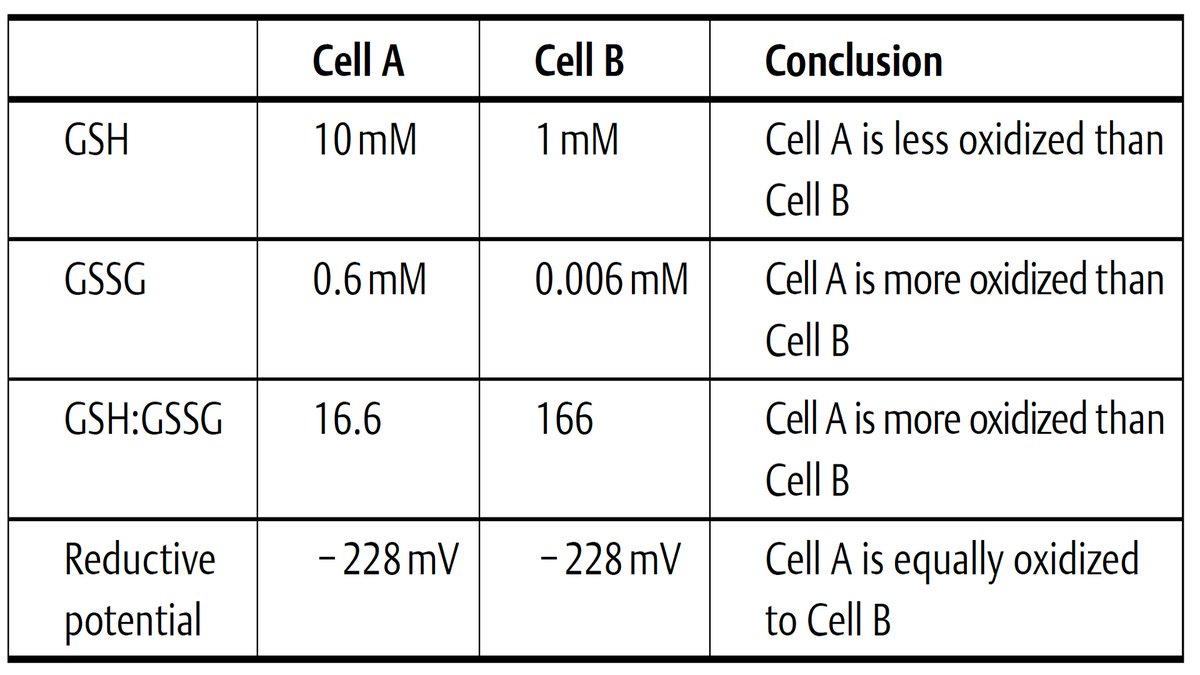1/Do numbers matter in redox biology?
In our new paper “Quantitative Redox Biology of Exercise” with @margaritelis and @Anton_Matsakas we present the kinetic concepts, numbers and equations to perform “street fighting” quantitation in redox biology.
https://www.thieme-connect.com/products/ejournals/abstract/10.1055/a-1157-9043">https://www.thieme-connect.com/products/...
In our new paper “Quantitative Redox Biology of Exercise” with @margaritelis and @Anton_Matsakas we present the kinetic concepts, numbers and equations to perform “street fighting” quantitation in redox biology.
https://www.thieme-connect.com/products/ejournals/abstract/10.1055/a-1157-9043">https://www.thieme-connect.com/products/...
2/Too much data and concepts in redox biology.
However, many are conflicting or might not make sense.
Example: the concentration of hydrogen peroxide in muscle is debatable and it is unknown how much has to be increased to transduce signaling.
However, many are conflicting or might not make sense.
Example: the concentration of hydrogen peroxide in muscle is debatable and it is unknown how much has to be increased to transduce signaling.
3/Part of the difficulty lies in the absence of solid quantitative information regarding basic redox biology measures.
This is evident by the prevalence and limitations of the two most frequently used frameworks to explain changes in RONS levels:
 https://abs.twimg.com/emoji/v2/... draggable="false" alt="👇" title="Down pointing backhand index" aria-label="Emoji: Down pointing backhand index">
https://abs.twimg.com/emoji/v2/... draggable="false" alt="👇" title="Down pointing backhand index" aria-label="Emoji: Down pointing backhand index">
This is evident by the prevalence and limitations of the two most frequently used frameworks to explain changes in RONS levels:
4/The “oxidants/antioxidants seesaw” model
is inadequate mainly because the different oxidants and antioxidants are not equal and, therefore, cannot be “weighed”.
is inadequate mainly because the different oxidants and antioxidants are not equal and, therefore, cannot be “weighed”.
5/The “RONS triangle” model
is inadequate mainly because the driver of redox biology is the vague level of a RONS that directs trinary outputs emphasizing RONS levels instead of circuitry and neglecting the role of other molecules.
is inadequate mainly because the driver of redox biology is the vague level of a RONS that directs trinary outputs emphasizing RONS levels instead of circuitry and neglecting the role of other molecules.
6/Aim
Providing key numbers that describe the redox world using examples from exercise physiology.
Providing key numbers that describe the redox world using examples from exercise physiology.
7/1st part
We explain the very basic chemical kinetics concepts in order to appreciate the factors that govern the speed of redox reactions:
i) the rate constant of a reaction (k)
ii) the concentrations of the reactants
Reaction rate = k[A][B]
We explain the very basic chemical kinetics concepts in order to appreciate the factors that govern the speed of redox reactions:
i) the rate constant of a reaction (k)
ii) the concentrations of the reactants
Reaction rate = k[A][B]
8/The steady state of a RONS is reached when the rates of formation (V formation) are balanced by the rates of consumption (V consumption):
[RONS]ss = V formation /(k consumption + k signaling)
Example:
[H2O2]ss = V NADPH oxidases /(k GPx + k Prx + k sulfur switches)
[RONS]ss = V formation /(k consumption + k signaling)
Example:
[H2O2]ss = V NADPH oxidases /(k GPx + k Prx + k sulfur switches)
9/The time (t) it takes for a RONS to diffuse a distance (L) is determined by its diffusion constant (D):
t = L^2/D
The time required for H2O2 to diffuse across the erythrocyte is:
t = L^2/D = 49/2000 = 24.5 ms
Unlikely considering that the half-life of H2O2 is 0.01–1 ms.
t = L^2/D
The time required for H2O2 to diffuse across the erythrocyte is:
t = L^2/D = 49/2000 = 24.5 ms
Unlikely considering that the half-life of H2O2 is 0.01–1 ms.
10/The rate of scavenging radicals by antioxidants is determined by the rate constant (k) of reaction between the antioxidant and radical as well as the concentration of the antioxidant and radical:
Rate of radical scavenging = k antioxidant + radical × [antioxidant] [radical]
Rate of radical scavenging = k antioxidant + radical × [antioxidant] [radical]
11/2nd part
Based on literature analysis, we provide the most reliable* concentrations in blood & muscle for:
-superoxide
-hydrogen peroxide
-nitric oxide
-vit C
-vit E
-glutathione
Necessary for study design in exercise physiology/nutrition.
*equivocal in many cases
Based on literature analysis, we provide the most reliable* concentrations in blood & muscle for:
-superoxide
-hydrogen peroxide
-nitric oxide
-vit C
-vit E
-glutathione
Necessary for study design in exercise physiology/nutrition.
*equivocal in many cases
12/The three primary RONS are found at very low concentrations (nano- to picomolar).
This is important because it shows:
i) how efficient the antioxidant system is
ii) only a small increase in RONS production at microdomains can exponentially increase their concentration.
This is important because it shows:
i) how efficient the antioxidant system is
ii) only a small increase in RONS production at microdomains can exponentially increase their concentration.
13/The long-suffering GSH:GSSG couple has been an attractive target for applying quantitative approaches.
It seems that all numerical attempts have limitations.
Contradictory messages can emerge from different calculations that aim to describe the same thing (redox status).
It seems that all numerical attempts have limitations.
Contradictory messages can emerge from different calculations that aim to describe the same thing (redox status).
14/3rd part
The effect of exercise on superoxide, hydrogen peroxide and nitric oxide levels in skeletal muscle (26 studies).
We show that acute exercise increases RONS levels in cytosol or whole muscle but not in mitochondria (discrepant data).
The effect of exercise on superoxide, hydrogen peroxide and nitric oxide levels in skeletal muscle (26 studies).
We show that acute exercise increases RONS levels in cytosol or whole muscle but not in mitochondria (discrepant data).
15/We found that one bout of exercise increases hydrogen peroxide levels by 64%.
Is this increase sufficient to be sensed by redox-sensitive proteins and transduce signaling?
Our calculations say NO, unless, hydrogen peroxide increases much more in specific microdomains.
Is this increase sufficient to be sensed by redox-sensitive proteins and transduce signaling?
Our calculations say NO, unless, hydrogen peroxide increases much more in specific microdomains.
16/These basic concentrations, kinetic values and equations can take us one step closer to redox reality.
Surely numbers are useless without a proper framework.
For how to breathe life to dry data, you can see our paper inspired by the movie “Rashomon”: https://onlinelibrary.wiley.com/doi/abs/10.1002/bies.201800041">https://onlinelibrary.wiley.com/doi/abs/1...
Surely numbers are useless without a proper framework.
For how to breathe life to dry data, you can see our paper inspired by the movie “Rashomon”: https://onlinelibrary.wiley.com/doi/abs/10.1002/bies.201800041">https://onlinelibrary.wiley.com/doi/abs/1...
17/Hoping that our paper be a useful quantitative companion to these excellent reviews:
https://bit.ly/35Bn6Ew
https://bit.ly/35Bn6Ew&q... href=" https://bit.ly/3ba7J74
https://bit.ly/3ba7J74&q... href=" https://bit.ly/2WaEmO1
https://bit.ly/2WaEmO1&q... href=" https://bit.ly/2ywQFuU
https://bit.ly/2ywQFuU&q... href=" https://bit.ly/2SGBSVd
https://bit.ly/2SGBSVd&q... href=" https://bit.ly/2W5ZiWj
https://bit.ly/2W5ZiWj&q... href=" https://bit.ly/2W8xznL ">https://bit.ly/2W8xznL&q... https://bit.ly/3fjeG9r ">https://bit.ly/3fjeG9r&q...
https://bit.ly/35Bn6Ew
18/Invaluable books for anyone looking for quantitative data in biology:
Cell Biology by the Numbers by Milo & Philips
https://www.amazon.com/Cell-Biology-Numbers-Ron-Milo/dp/0815345372
Physical">https://www.amazon.com/Cell-Biol... Biology of the Cell by Philips, Kondev & Theriot https://www.amazon.com/Physical-Biology-Cell-Rob-Phillips/dp/0815344503">https://www.amazon.com/Physical-...
Cell Biology by the Numbers by Milo & Philips
https://www.amazon.com/Cell-Biology-Numbers-Ron-Milo/dp/0815345372
Physical">https://www.amazon.com/Cell-Biol... Biology of the Cell by Philips, Kondev & Theriot https://www.amazon.com/Physical-Biology-Cell-Rob-Phillips/dp/0815344503">https://www.amazon.com/Physical-...
19/Our paper could not have been written but for the following computational papers:
https://www.sciencedirect.com/science/article/pii/S2213231717301891">https://www.sciencedirect.com/science/a...
https://www.sciencedirect.com/science/article/abs/pii/S1089860396901123?via%3Dihub">https://www.sciencedirect.com/science/a...
https://www.sciencedirect.com/science/article/abs/pii/S0891584916302155">https://www.sciencedirect.com/science/a...
https://www.sciencedirect.com/science/article/pii/S2213231716303469?via%3Dihub
Particularly">https://www.sciencedirect.com/science/a... Antunes & Brito (2017) served both as inspiration and guide during the writing.
https://www.sciencedirect.com/science/article/pii/S2213231717301891">https://www.sciencedirect.com/science/a...
https://www.sciencedirect.com/science/article/abs/pii/S1089860396901123?via%3Dihub">https://www.sciencedirect.com/science/a...
https://www.sciencedirect.com/science/article/abs/pii/S0891584916302155">https://www.sciencedirect.com/science/a...
https://www.sciencedirect.com/science/article/pii/S2213231716303469?via%3Dihub
Particularly">https://www.sciencedirect.com/science/a... Antunes & Brito (2017) served both as inspiration and guide during the writing.
Fin/
Corrections and suggestions are more than welcomed.
We hope that this paper initiates a dialogue in redox numerical biology.
Read the paper if you want to know more and check for yourself!
Corrections and suggestions are more than welcomed.
We hope that this paper initiates a dialogue in redox numerical biology.
Read the paper if you want to know more and check for yourself!

 Read on Twitter
Read on Twitter








